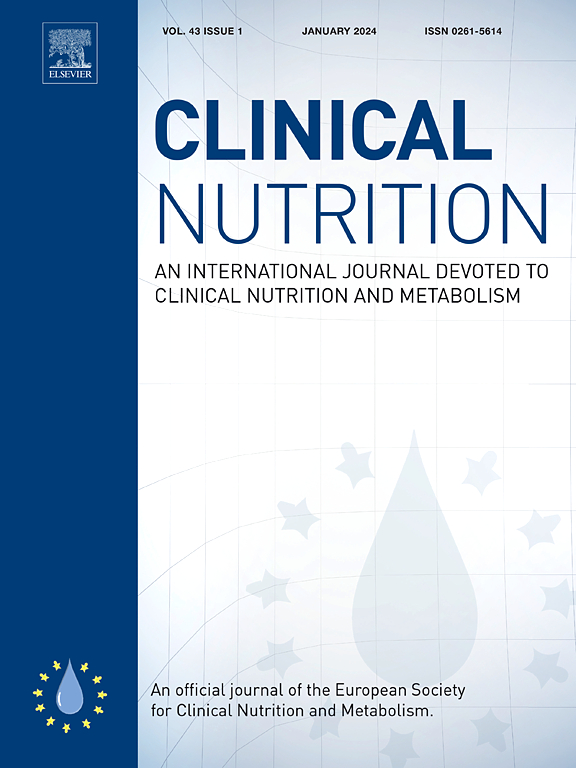Implementing the Global Leadership Initiative on Malnutrition (GLIM) criteria in Crohn's disease: Prevalence of malnutrition and association with clinical outcomes
IF 6.6
2区 医学
Q1 NUTRITION & DIETETICS
引用次数: 0
Abstract
Background & aims
Limited data exist regarding the implementation of the Global Leadership Initiative on Malnutrition (GLIM) criteria for diagnosing malnutrition in Crohn's disease (CD), and its association with CD prognosis. In the present study eighteen GLIM combinations and a combined one were implemented to identify differences in the prevalence of malnutrition and to investigate potential associations with clinical outcomes at 6 months.
Methods
Different methodologies to diagnose malnutrition were used at baseline, namely the Subjective Global Assessment (SGA), eighteen different combinations of phenotypic and etiologic GLIM criteria and a combined version based on all GLIM combinations (GLIMcv) to test differences in the estimated prevalence and outcomes’ prognosis. At 6 months, data for clinical outcomes were collected (i.e. hospitalization, antibiotics use, intensification/change of biologic agent, initiation of biologic agent/corticosteroids, surgery, disease activity), and an overall adverse clinical outcome index was created.
Results
250 people with CD (54.8 % males, mean age 41.2 ± 14.1 years, 37.2 % with active disease) were enrolled. Prevalence of malnutrition based on SGA and GLIMcv was 23 % and 52 %, respectively, and 5.8–63 % based on different GLIM combinations. Malnutrition diagnosed with GLIMcv was associated with an increased likelihood of intensification/change of biologic agent [Odds ratio (OR): 1.82, 95 % Confidence interval (CI): 1.00–3.42, p = 0.05] and an overall adverse clinical outcome (OR: 2.18, 95 % CI: 1.23–3.87, p = 0.008) at 6 months, after adjustment for age, sex, disease location and duration. Malnutrition diagnosed through SGA was not associated with clinical outcomes at 6 months.
Conclusions
Based on GLIMcv, half of the sample was diagnosed with malnutrition. Malnutrition significantly increased the likelihood of uncontrolled disease requiring treatment upgrading and leading to an overall adverse clinical outcome short term.
在克罗恩病中实施全球营养不良领导倡议(GLIM)标准:营养不良患病率及其与临床结果的关系。
背景与目的:有关克罗恩病(CD)患者营养不良诊断的全球营养不良领导倡议(GLIM)标准的实施情况及其与CD预后的关系的数据有限。本研究采用了 18 种 GLIM 组合和一种合并标准,以确定营养不良发生率的差异,并研究其与 6 个月临床预后的潜在关联:基线时使用不同的方法诊断营养不良,即主观全面评估(SGA)、18种不同的表型和病因GLIM标准组合以及基于所有GLIM组合的合并版本(GLIMcv),以检验估计患病率和预后结果的差异。结果:250 名 CD 患者(54.8% 为男性,平均年龄为 41.2 ± 14.1 岁,37.2% 为活动性疾病患者)被纳入研究。基于 SGA 和 GLIMcv 的营养不良发生率分别为 23% 和 52%,基于不同 GLIM 组合的营养不良发生率为 5.8-63%。在对年龄、性别、发病部位和病程进行调整后,通过 GLIMcv 诊断出的营养不良与加强/更换生物制剂的可能性增加有关[比值比 (OR):1.82,95 % 置信区间 (CI):1.00-3.42,p = 0.05],与 6 个月后的总体不良临床结果有关(OR:2.18,95 % CI:1.23-3.87,p = 0.008)。通过 SGA 诊断出的营养不良与 6 个月后的临床结果无关:结论:根据 GLIMcv,半数样本被诊断为营养不良。营养不良会大大增加病情失控、需要升级治疗的可能性,并导致短期内总体不良的临床结果。
本文章由计算机程序翻译,如有差异,请以英文原文为准。
求助全文
约1分钟内获得全文
求助全文
来源期刊

Clinical nutrition
医学-营养学
CiteScore
14.10
自引率
6.30%
发文量
356
审稿时长
28 days
期刊介绍:
Clinical Nutrition, the official journal of ESPEN, The European Society for Clinical Nutrition and Metabolism, is an international journal providing essential scientific information on nutritional and metabolic care and the relationship between nutrition and disease both in the setting of basic science and clinical practice. Published bi-monthly, each issue combines original articles and reviews providing an invaluable reference for any specialist concerned with these fields.
 求助内容:
求助内容: 应助结果提醒方式:
应助结果提醒方式:


